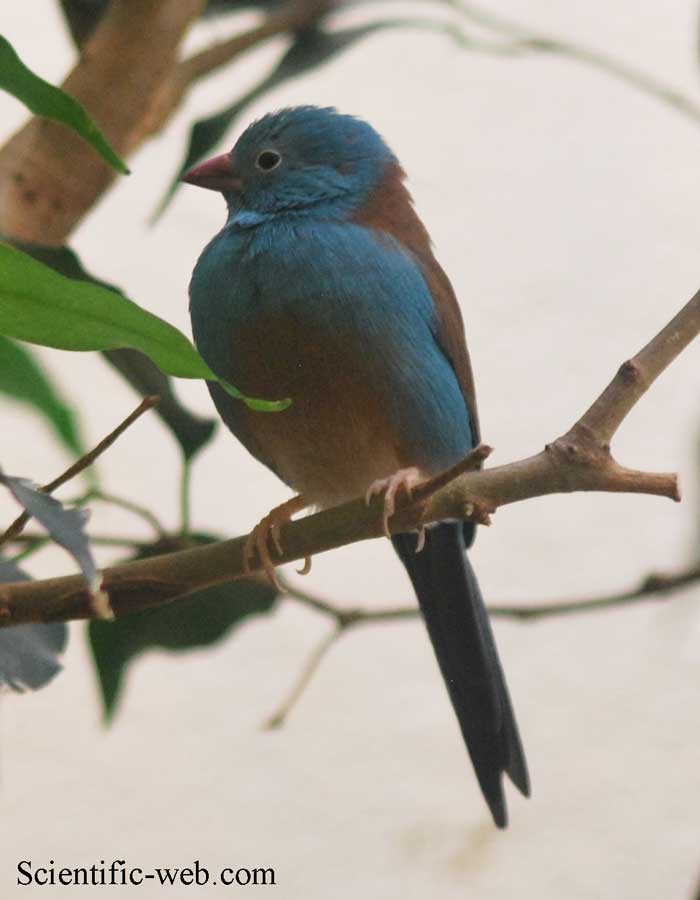
Uraeginthus cyanocephalus, Photo: Michael Lahanas
Superregnum: Eukaryota
Regnum: Animalia
Subregnum: Eumetazoa
Cladus: Bilateria
Cladus: Nephrozoa
Superphylum: Deuterostomia
Phylum: Chordata
Cladus: Craniata
Subphylum: Vertebrata
Infraphylum: Gnathostomata
Superclassis: Tetrapoda
Cladus: Reptiliomorpha
Cladus: Amniota
Classis: Reptilia
Cladus: Eureptilia
Cladus: Romeriida
Subclassis: Diapsida
Cladus: Sauria
Infraclassis: Archosauromorpha
Cladus: Crurotarsi
Divisio: Archosauria
Subsectio: Ornithodira
Subtaxon: Dinosauromorpha
Cladus: Dinosauria
Ordo: Saurischia
Cladus: Eusaurischia
Cladus: Theropoda
Cladus: Neotheropoda
Infraclassis: Aves
Ordo: Passeriformes
Subordo: Passeri
Infraordo: Passerida
Superfamilia: Passeroidea
Familia: Estrildidae
Genus: Uraeginthus
Species: Uraeginthus cyanocephalus
Name
Uraeginthus cyanocephalus (Richmond, 1897)
References
Auk 14 p. 157
Vernacular names
čeština: motýlek modrohlavý
English: Blue-capped cordon-bleu
español: Azulito coroniazul
suomi: Sinipääpeippo
français: Cordonbleu cyanocéphale
magyar: Kékfejű pillangópinty
italiano: Astrilde testa blu
norsk: Blåhodeastrild
svenska: Blåhuvad fjärilsfink
中文: 蓝顶蓝饰雀
The blue-capped cordon-bleu or blue-capped cordonbleu (Uraeginthus cyanocephalus) is native to Ethiopia, Kenya, Somalia, South Sudan, and Tanzania in East Africa. This small finch does fairly well in captivity given adequate conditions; however, breeding this finch is said to be quite difficult.
Habitat
The blue-capped cordon-bleu inhabits the subtropical or tropical (lowland) dry grasslands, shrublands, and deserts of subsaharan Africa. It has an estimated global extent of occurrence of 390,000 km2.
Feature
The finch is an omnivorous passerine eating seeds and small insects. Most of this species do not exceed 7.5 cm (3.0 in) in length and are quiet relative to other finches.
Males have blue on the tops of their heads and tend to be more vivid in colour. On female blue-caps the light brown coloration on the wings extends to the nape of the neck and over the top the head. Pairs dance holding twigs in their beaks, and film using a high-speed camera shows partners tapping their feet between twenty-five and fifty times a second, making a buzzing sound.[2]
Origin
Origin and phylogeny has been obtained by Antonio Arnaiz-Villena et al.[3] Estrildinae may have originated in India and dispersed thereafter (towards Africa and Pacific Ocean habitats).
References
Wikimedia Commons has media related to Uraeginthus cyanocephalus.
BirdLife International (2018). "Uraeginthus cyanocephalus". IUCN Red List of Threatened Species. 2018: e.T22719499A132130104. doi:10.2305/IUCN.UK.2018-2.RLTS.T22719499A132130104.en. Retrieved 11 November 2021.
"Tap dancing bird is one-man band". New Scientist. 228 (3049): 20. 28 November 2015. doi:10.1016/S0262-4079(15)31698-5.
Arnaiz-Villena, A; Ruiz-del-Valle V; Gomez-Prieto P; Reguera R; Parga-Lozano C; Serrano-Vela I (2009). "Estrildinae Finches (Aves, Passeriformes) from Africa, South Asia and Australia: a Molecular Phylogeographic Study" (PDF). The Open Ornithology Journal. 2: 29–36. doi:10.2174/1874453200902010029.
Retrieved from "http://en.wikipedia.org/"
All text is available under the terms of the GNU Free Documentation License

